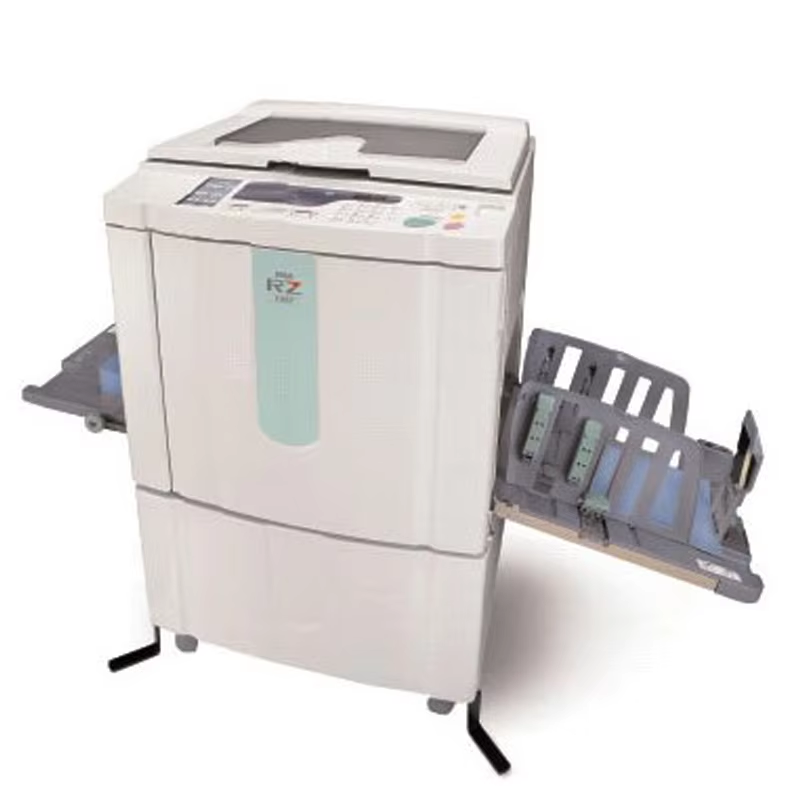การเข้าใจ เครื่องถ่ายเอกสาร การทํางาน
การปรับเทียบเพื่อคุณภาพของผลลัพธ์ที่สม่ำเสมอ
การ head ที่เหมาะสมเป็นสิ่งสำคัญเพื่อให้มั่นใจว่าเครื่องดูเพล็กซ์กำลังให้ผลลัพธ์คุณภาพสูงอย่างต่อเนื่อง จำเป็นต้องให้ความสำคัญกับการ head สีและการกำหนดขอบ ซึ่งเป็นปัจจัยหลักสำหรับการถ่ายเอกสารที่แม่นยำ การ head ไม่เพียงแต่ช่วยให้แน่ใจว่าเครื่องดูเพล็กซ์ทำงานได้อย่างถูกต้องตามที่ต้องการ แต่ยังสามารถช่วยตรวจพบปัญหาเล็กๆ ก่อนที่จะกลายเป็นเหตุฉุกเฉิน เพื่อทำการ head อย่างมีประสิทธิภาพ ควรอ้างอิงคำแนะนำจากผู้ผลิตที่มักจะมาพร้อมขั้นตอนทีละขั้นสำหรับแต่ละรุ่น เช่น บริษัทแนะนำให้ปรับแต่งและ head การตั้งค่าสีของเครื่องดูเพล็กซ์อย่างน้อยเดือนละครั้ง การวัดความแม่นยำของสีสามารถเป็นประโยชน์มาก โดยใช้อุปกรณ์เช่น spectrophoto meter และซอฟต์แวร์เฉพาะก็สามารถช่วยในการปรับแต่งได้
- เริ่มต้นด้วยรอบการพิมพ์ที่สะอาดเพื่อกำจัดตัวแปรใด ๆ
- ใช้เครื่องมือปรับเทียบสีเพื่อปรับผลลัพธ์ของสี
- ใช้ไม้บรรทัดหรือแผ่นปรับแนวเพื่อตรวจสอบการจัดเรียงของการพิมพ์
การวิจัยเน้นย้ำถึงความเชื่อมโยงระหว่างการสอบเทียบเป็นประจำกับคุณภาพการผลิตที่ยอดเยี่ยม การศึกษาที่ตีพิมพ์ใน "Print Technology Insights" เผยว่าธุรกิจที่สอบเทียบเครื่องดูプリเตอร์ของพวกเขาทุกเดือนจะมีการปรับปรุงความละเอียดและความสม่ำเสมอของการพิมพ์สูงขึ้น 25%
การกำหนดลำดับการทำงานที่เหมาะสม
ลำดับการทำงานที่มีประสิทธิภาพ กระบวนการทำงานที่เกี่ยวข้องกับการใช้งานเครื่องดูเพลิกเตอร์เป็นสิ่งสำคัญเพื่อให้มั่นใจว่าจะมีการจัดการเอกสารได้อย่างราบรื่น ตั้งแต่ขั้นตอนเตรียมงานจนถึงขั้นตอนสุดท้าย ลำดับการทำงานทั่วไปประกอบด้วยการจัดรูปแบบงานพิมพ์ การใช้ธีมโฆษณาหรือการเผยแพร่ และการบันทึกภาพพิมพ์ การสร้างลำดับเหล่านี้จะช่วยกำจัดจุดคอขวดและส่งเสริมความมีประสิทธิภาพ การใช้แผนภูมิแสดงลำดับขั้นตอนอาจทำให้ผู้ปฏิบัติงานเข้าใจและดำเนินการตามขั้นตอนเหล่านี้ได้ง่ายขึ้น
- เริ่มจากการจัดระเบียบเอกสารตามลำดับความสำคัญและขนาด
- ปรับตั้งค่าบนเครื่องดูเพล็กเตอร์สำหรับงานเฉพาะประเภท
- จัดการกระบวนการหลังการผลิตตามลักษณะของผลลัพธ์สุดท้าย เช่น การรวมเอกสารหรือการเย็บเล่ม
พิจารณาเรื่องราวความสำเร็จของ XYZ Corporation ซึ่งได้ปรับปรุงกระบวนการทำงานของเครื่องดูเพล็กเตอร์โดยการนำกระบวนการทำงานที่มีโครงสร้างมาใช้งาน โดยการจัดระเบียบใหม่ในกระบวนการจัดการเอกสาร พวกเขาสามารถลดเวลาในการทำงานให้เสร็จสิ้นลงได้ 40% และเพิ่มคุณภาพของผลลัพธ์อย่างเห็นได้ชัด ตามที่ได้เน้นไว้ใน "Office Technology Journal" การนำกระบวนการทำงานเหล่านี้มาใช้สามารถลดความล่าช้าในการผลิตได้อย่างมาก
หลีกเลี่ยงข้อผิดพลาดในการตั้งค่าทั่วไป
เครื่องถ่ายเอกสาร การติดตั้งบางครั้งอาจมีปัญหา ส่งผลต่อการทำงานและความแม่นยำของผลลัพธ์ ข้อผิดพลาดทั่วไปเกี่ยวข้องกับการโหลดสื่อและการตั้งค่าที่ไม่เหมาะสม ข้อผิดพลาดเหล่านี้อาจทำให้เกิดปัญหากระดาษติด งานพิมพ์เอียงหรือไม่ตรงตำแหน่ง หรือการใช้งานที่ไม่มีประสิทธิภาพ เมื่อแก้ไขปัญหา ควรจัดการกับปัญหาแต่ละอย่างอย่างเป็นระบบเมื่อเกิดขึ้น
- ตรวจสอบให้แน่ใจว่าสื่อและขนาดที่ติดตั้งไว้มีความเหมาะสมตามข้อกำหนดของงาน
- ตรวจสอบการตั้งค่าบ่อยๆ โดยเฉพาะหลังจากการบำรุงรักษา
- ใช้รายการตรวจสอบเพื่อยืนยันว่าแต่ละขั้นตอนได้รับการตั้งค่าอย่างถูกต้องแล้ว
และ ท้ายที่สุดแล้ว ผลกระทบที่เกิดจากความผิดพลาดดังกล่าวอาจมีขนาดใหญ่หลวงได้ การวิจัยแสดงให้เห็นว่าความผิดพลาดในการดำเนินการได้นำไปสู่ช่วงเวลาการหยุดทำงานที่ยาวนาน ซึ่งแน่นอนว่าไม่ดีต่อธุรกิจ การเพิ่มภาพประกอบลงในลิสต์ตรวจสอบช่วยให้ผู้ใช้งานหลีกเลี่ยงข้อผิดพลาดบางอย่างได้อย่างมีประสิทธิภาพมากขึ้น ตามที่รายงาน "Office Workflow Analytics" ระบุว่า วิธีที่น่าสนใจสำหรับสำนักงานในการปรับปรุงกระบวนการตั้งค่าเครื่องพิมพ์คือการทบทวนและอัปเดตขั้นตอนการตั้งค่าเป็นประจำ และยังคงมีฟีเจอร์หนึ่งที่สามารถเพิ่มประสิทธิภาพของการตั้งค่าได้อีก 30%
การพัฒนาวิธีการจัดการไฟล์
การนำหลักปฏิบัติที่ดีที่สุดของเมตาดาต้ามาใช้
เมตาดาต้ามีความสำคัญเมื่อทำงานร่วมกับโปรแกรมสำเนาเพื่อจัดการไฟล์อย่างมีประสิทธิภาพ มันเพิ่มความสามารถในการค้นหาและการจัดระเบียบ ซึ่งช่วยให้ผู้ใช้งานสามารถค้นหาและจัดการไฟล์ได้ง่ายขึ้น การปฏิบัติตามแนวทางที่ดีที่สุดเกี่ยวกับเมตาดาต้าสามารถเพิ่มประสิทธิภาพการทำงานได้ หนึ่งในนั้นคือการติดแท็กไฟล์ด้วยคำหลักและวันที่ จากนั้นแบ่งปันระหว่างบุคคล ตัวอย่างเช่น ไฟล์ที่ถูกจัดระเบียบด้วยเมตาดาต้าจะลดเวลาที่ใช้ในการค้นหาและให้การเข้าถึงแบบรวดเร็วไปยังฟอร์มที่สำคัญ การศึกษาครั้งหนึ่งประมาณการว่าการใช้เมตาดาต้าอย่างมีประสิทธิภาพสามารถลดเวลาที่ใช้ในการค้นหาไฟล์ลงได้ 30% โดยเน้นย้ำถึงผลกระทบในแง่ของประสิทธิภาพในการดำเนินงาน
การปรับปรุงกระบวนการทำดิจิทัลคอนเวอร์ชัน
กระบวนการแปลงกระดาษเป็นสื่ออิเล็กทรอนิกส์เป็นปัจจัยสำคัญในการใช้ระบบการจัดการเอกสารอิเล็กทรอนิกส์เพื่อปรับปรุงวิธีการจัดการแฟ้มเอกสารให้มีประสิทธิภาพมากขึ้น การแปลงดิจิทัลที่มีคุณภาพดียังช่วยบันทึกข้อมูลได้อย่างแม่นยำและทำให้เข้าถึงข้อมูลได้ง่ายขึ้น ผลลัพธ์สุดท้ายจะถูกสร้างขึ้นโดยใช้เครื่องมือขั้นสูงสำหรับการสแกน/แปลงดิจิทัล (เช่น ซอฟต์แวร์รู้จำตัวอักษรออปติคอล (OCR)) เพื่อให้มั่นใจในความแม่นยำและความรวดเร็วในการดำเนินการ นอกจากนี้ ด้วยกระบวนการดิจิทัลที่มีประสิทธิภาพ ไฟล์สามารถเข้าถึงและคัดลอกได้ง่าย เมื่อดำเนินการดิจิทัลตามประสบการณ์การจัดการคลังข้อมูลและการรายงานจากหลายอุตสาหกรรม จะพบว่ามีการลดข้อผิดพลาดในการประมวลผลและเพิ่มความสามารถในการเข้าถึงไฟล์ ซึ่งทำให้ความเร็วของการดิจิทัลกลายเป็นทรัพยากรที่สำคัญ
เทคนิคเพิ่มประสิทธิภาพการประมวลผลแบบแบทช์
การประมวลผลแบบแบทช์สามารถคัดลอกกระบวนการทำงานได้ด้วยข้อได้เปรียบที่สำคัญ โดยหลักๆ แล้วผ่านการลดเวลาในการเสร็จสิ้นงาน การประมวลผลแบบแบทช์ในท่อส่งสามารถนำมาซึ่งประโยชน์อย่างมากในแง่ของประสิทธิภาพ เพื่อให้ได้ประสิทธิภาพสูงสุด ควรมีการใช้ศักยภาพของเครื่องอย่างเต็มที่และรวมงานที่มีการประมวลผลคล้ายกัน เทคนิคที่ใช้รวมถึงการปรับแต่งการตั้งค่าแบทช์และการวางแผนเพื่อเพิ่มปริมาณงานที่ผ่านไป เราแสดงให้เห็นเชิงประสบการณ์ว่าประโยชน์ของการประมวลผลแบบแบทช์มีความสำคัญ โดยมีการลดเวลาในการเสร็จสิ้นลงได้ถึง 40% เมื่อเทียบกับการประมวลผลแบบลำดับ ความคิดเห็นยืนยันผลลัพธ์ โดยเน้นว่าการประมวลผลแบบแบทช์เป็นสิ่งจำเป็นสำหรับการดำเนินงานของตัวคัดลอกอย่างมีประสิทธิภาพ
โปรโตคอลความปลอดภัยและการจัดการการเข้าถึง
การกำหนดสิทธิ์ตามบทบาท
สิทธิ์ตามบทบาทเพิ่มความปลอดภัยอีกชั้นให้กับกระบวนการทำงานของการคัดลอกของคุณ เนื่องจากคุณสามารถมอบสิทธิ์การเข้าถึงให้เฉพาะบุคคลที่กำหนดได้ วิธีการเชิงระบบดังกล่าวปกป้องข้อมูลที่ละเอียดอ่อนโดยการจำกัดการเข้าถึงตามบทบาทหรือหน้าที่ของบุคคลในองค์กร นี่คือวิธีการตั้งค่าสิทธิ์เหล่านี้อย่างมีประสิทธิภาพ: เริ่มต้นด้วยการกำหนดบทบาทที่มีอยู่ในทีมของคุณ และข้อมูลหรือฟังก์ชันของข้อมูลใดที่แต่ละบทบาทควรเห็น จากนั้นตั้งค่าสิทธิ์ที่สอดคล้องกับบทบาทเหล่านั้น เช่น สิทธิ์ในการอ่าน เขียน หรือดำเนินการ ตามรายงานความปลอดภัยของ IBM “องค์กรที่มีผู้ใช้งานมากกว่า 75,000 คนซึ่งมีระดับสิทธิ์ตามบทบาทที่แข็งแกร่ง จะมีอัตราเฉลี่ยของการบันทึกข้อมูลที่ถูกโจมตีลดลง 30% ในกรณีที่เกิดการละเมิดข้อมูล” ซึ่งเป็นหลักฐานเพิ่มเติมถึงประสิทธิภาพของสิทธิ์ตามบทบาทในการปกป้องข้อมูลที่ละเอียดอ่อนขององค์กร และสถิติเหล่านี้เน้นย้ำถึงความสำคัญของโซลูชันสิทธิ์ตามบทบาทที่มีประสิทธิภาพในการปกป้องข้อมูลของบริษัท
การนำเอา Audit Trail มาใช้เพื่อความรับผิดชอบ
ต้องมีการบันทึกกิจกรรมของผู้ดูแลระบบเพื่อให้สามารถติดตามการกระทำของผู้ใช้งาน และบังคับใช้ความรับผิดชอบได้ การตรวจสอบอย่างมีประสิทธิภาพจะติดตามกิจกรรมทั้งหมดของผู้ใช้งานในระบบ เช่น การแก้ไขไฟล์หรือเวลาเข้าถึง ซึ่งจะส่งมอบประวัติที่สมบูรณ์ของการดำเนินงานที่เกิดขึ้น เพื่อตั้งค่าโปรแกรมนี้ ควรกำหนดก่อนว่าคุณต้องการตรวจสอบการกระทำใด จากนั้นหาเครื่องมือตรวจสอบที่สามารถเชื่อมโยงกับแพลตฟอร์มปัจจุบันของคุณได้อย่างง่ายดาย ตรวจสอบบันทึกการตรวจสอบเป็นประจำเพื่อตรวจพบกิจกรรมที่น่าสงสัยหรือไม่ได้รับอนุญาต และป้องกันการโจมตีด้านความปลอดภัย นอกจากนี้ SANS ยังเผยแพร่รายงานที่พวกเขาชี้ให้เห็นว่าองค์กรที่มีเส้นทางการตรวจสอบที่ประสบความสำเร็จ มีจำนวนการเข้าถึงโดยไม่ได้รับอนุญาตลดลง ซึ่งเน้นย้ำถึงคุณค่าของระบบนี้ในการรักษากระบวนการรับผิดชอบด้านความปลอดภัย การใช้งานและการจัดการเส้นทางการตรวจสอบไม่เพียงแต่ติดตามพฤติกรรมของผู้ใช้งานเท่านั้น แต่ยังสร้างสภาพแวดล้อมการทำงานที่ปลอดภัยและมีความรับผิดชอบมากขึ้น
โปรโตคอลการบำรุงรักษาเครื่องจักรอย่างมีประสิทธิภาพ
ขั้นตอนการทำความร้อนก่อนการปฏิบัติงาน
การทำขั้นตอนการทำความร้อนก่อนการปฏิบัติงานเป็นสิ่งสำคัญสำหรับการรับประกันประสิทธิภาพที่ดีที่สุดและความทนทานของเครื่องสำเนา โดยการนำแนวทางเหล่านี้ไปใช้ เราสามารถป้องกันการสึกหรอและการเสียหายก่อนเวลา และเพิ่มประสิทธิภาพของเครื่องได้ ต่อไปนี้คือรายการตรวจสอบแนะนำของการทำขั้นตอนการทำความร้อนที่ควรปฏิบัติตาม:
- เริ่มต้นด้วยการตรวจสอบทางสายตา: ตรวจสอบสัญญาณที่มองเห็นได้ของความสึกหรอหรือความเสียหาย
- รัน cylce การทดสอบ: ตรวจสอบให้แน่ใจว่าชิ้นส่วนที่เคลื่อนที่ทั้งหมดทำงานได้อย่างลื่นไหล
- ปรับการตั้งค่าอุณหภูมิ: ตั้งค่าอุณหภูมิตามข้อมูลจำเพาะของวัสดุ
การศึกษาแสดงให้เห็นว่าเครื่องจักรที่มีโปรโตคอลการอุ่นเครื่องเป็นประจำจะมีความน่าเชื่อถือเพิ่มขึ้น 20% และอายุการใช้งานยาวนานขึ้น ตามที่รายงานโดย [การศึกษาอุตสาหกรรม](https://www.machinemaintenance.com/reliability-studies)
ความเข้ากันได้ของวัสดุและการเลือกใช้
การเลือกวัสดุที่เข้ากันได้สำหรับใช้งานร่วมกับเครื่องดูเพล็กซ์นั้นมีความสำคัญในการป้องกันการติดขัดและทำให้ได้ผลลัพธ์คุณภาพสูง การใช้วัสดุที่ไม่เข้ากันอาจนำไปสู่ปัญหาการบำรุงรักษาที่เพิ่มขึ้นและความเสียหายในคุณภาพของผลิตภัณฑ์ นี่คือวิธีที่คุณสามารถตรวจสอบการเลือกวัสดุที่เหมาะสม:
- อ้างอิงคำแนะนำจากผู้ผลิต: ปฏิบัติตามแนวทางเกี่ยวกับวัสดุที่เหมาะสม
- ทำการทดสอบความเข้ากันได้: ทดสอบวัสดุใหม่อย่างสม่ำเสมอเพื่อให้มั่นใจว่าสามารถทำงานร่วมกับเครื่องดูプリเคเตอร์ของคุณได้ดี
- consultar มาตรฐานของอุตสาหกรรม: ปรับใช้ทางเลือกของคุณให้สอดคล้องกับแนวทางปฏิบัติที่ดีที่สุดในอุตสาหกรรม
ตามการศึกษา เครื่องจักรที่ใช้วัสดุที่แนะนำจะมีคุณภาพผลผลิตดีขึ้น 15% และลดความถี่ของการหยุดชะงักในการทำงานลง
โซลูชันการเก็บรักษาที่ควบคุมสภาพอากาศ
การเก็บวัสดุสำหรับเครื่องดูプリเคเตอร์ในสภาพแวดล้อมที่ควบคุมอุณหภูมิเป็นสิ่งสำคัญสำหรับการรักษาคุณภาพและความสามารถในการทำงานของวัสดุ สภาพแวดล้อมที่ไม่เหมาะสมอาจทำให้คุณสมบัติของวัสดุเสื่อมลง ส่งผลกระทบต่อกระบวนการดูプリเคต สภาพแวดล้อมที่เหมาะสมรวมถึง:
- ระดับความชื้น: รักษาให้อยู่ระหว่าง 30-50% เพื่อป้องกันการบิดตัวของวัสดุ
- อุณหภูมิ: รักษาสภาพแวดล้อมให้คงที่ โดยเหมาะกับอุณหภูมิระหว่าง 20-25°C
- การระบายอากาศที่เหมาะสม: ตรวจสอบให้มีการไหลเวียนของอากาศเพียงพอเพื่อหลีกเลี่ยงการเก็บในสภาพที่ไม่มีอากาศถ่ายเท
การวิจัยเกี่ยวกับผลกระทบของปัจจัยสิ่งแวดล้อมแสดงให้เห็นว่าการจัดเก็บที่เหมาะสมสามารถขยายอายุการใช้งานของอุปกรณ์ได้ถึง 30% ตามที่บันทึกโดย [Material Science Reports](https://www.scienceandmaterial.com/studies/climate-impact)
การฝึกอบรมพนักงานและการควบคุมคุณภาพ
การพัฒนาโมดูลการฝึกอบรมอย่างครอบคลุม
การพัฒนาโปรแกรมฝึกอบรมที่มีประสิทธิภาพเป็นสิ่งสำคัญเพื่อให้แน่ใจว่าพนักงานได้รับการเตรียมความพร้อมอย่างดีในการทำงานกับเครื่องดูดซ้ำ โปรแกรมฝึกอบรมที่ดีควรมีสามลักษณะหลัก: ข้อมูลเชิงทฤษฎีเกี่ยวกับการใช้งานของเครื่อง, การฝึกปฏิบัติเพื่อพัฒนาทักษะสำคัญ และส่วนคำถามที่พบบ่อย (FAQs) อย่างละเอียดเพื่อตอบคำถามทั่วไป เพื่อประสบการณ์การเรียนรู้ที่แข็งแกร่งยิ่งขึ้น การสอนอาจเกิดขึ้นในเซสชันแบบโต้ตอบ, การถ่ายทอดความรู้ทางอิเล็กทรอนิกส์ และผ่านการนำเสนอวิดีโอเพื่อรองรับรูปแบบการเรียนรู้ที่หลากหลาย การศึกษาล่าสุดเน้นย้ำถึงข้อดีของการฝึกอบรม "ครบวงจร" ในการลด OFs และเพิ่มคุณภาพของผลผลิต "เราต้องการให้แน่ใจว่าทุกคนที่นี่ได้รับการฝึกอบรมจนมีความชำนาญในการใช้งานเครื่องดูดซ้ำ ซึ่งจะทำให้ภารกิจการทำงานมีประสิทธิผลมากขึ้นและลดโอกาสผิดพลาด"
การนำระบบตรวจสอบคิวพิมพ์มาใช้งาน
การตรวจสอบคิวพิมพ์เป็นสิ่งสำคัญสำหรับการระบุจุดคอขวดและการปรับปรุงการจัดสรรทรัพยากรภายในองค์กร โดยการตั้งระบบตรวจสอบที่มีประสิทธิภาพ องค์กรสามารถรับรองกระบวนการทำงานที่ลื่นไหลและควบคุมคุณภาพได้ดียิ่งขึ้น นี่คือคู่มือง่ายๆ ในการใช้งานการตรวจสอบคิวพิมพ์:
- ติดตั้งซอฟต์แวร์ตรวจสอบ : เลือกซอฟต์แวร์ที่น่าเชื่อถือซึ่งให้ความสามารถในการตรวจสอบแบบเรียลไทม์
- กำหนดการแจ้งเตือน : ตั้งการแจ้งเตือนสำหรับปัญหา เช่น กระดาษติดหรือหมึกเหลือน้อย เพื่อลดเวลาหยุดทำงาน
- วิเคราะห์ข้อมูล : ตรวจสอบการวิเคราะห์คิวพิมพ์เป็นประจำเพื่อปรับปรุงการจัดสรรทรัพยากรและการวางแผนงานให้ดีที่สุด
การนำระบบเหล่านี้ไปใช้งานได้ช่วยเพิ่มประสิทธิภาพในการดำเนินงานขององค์กรหลายแห่ง โดยมอบข้อมูลเชิงปฏิบัติเกี่ยวกับสมรรถนะของเครื่องจักร
สร้างต้นไม้การตัดสินใจแก้ปัญหา
ต้นไม้การตัดสินใจแก้ปัญหาถือเป็นแหล่งข้อมูลที่มีคุณค่าอย่างมากสำหรับผู้ปฏิบัติงานที่ดูแลเครื่องดublicator เครื่องมือที่มีแนวทางแบบภาพนี้จะแสดงวิธีแก้ปัญหาทีละขั้นตอนสำหรับปัญหาทั่วไป ซึ่งช่วยลดเวลาหยุดทำงานและเพิ่มประสิทธิภาพในการดำเนินงาน เพื่อสร้างต้นไม้การตัดสินใจที่ใช้งานง่าย:
- ระบุปัญหาทั่วไป : สร้างรายการปัญหาที่เกิดซ้ำ เช่น กระดาษติด เครื่องพิมพ์คุณภาพต่ำ และปัญหาการเชื่อมต่อ
- จับคู่วิธีแก้ไข : สร้างเส้นทางตรรกะที่นำไปสู่วิธีแก้ไขที่เป็นไปได้ เพิ่มความสะดวกในการนำทาง
- ทดสอบและปรับปรุง : อัปเดตต้นไม้เป็นประจำตามข้อเสนอแนะและความท้าทายทางเทคนิคที่เปลี่ยนไป
ตัวอย่างจากโลกความจริงแสดงให้เห็นว่าต้นไม้ในการตัดสินใจได้ช่วยลดเวลาซ่อมแซมและสนับสนุนพนักงานให้แก้ปัญหาได้อย่างอิสระและรวดเร็ว เครื่องมือเหล่านี้ไม่เพียงแต่สนับสนุนช่างเทคนิคเท่านั้น แต่ยังช่วยให้ผลลัพธ์ของการทำซ้ำมีความสม่ำเสมอและมีคุณภาพสูงขึ้น
การจัดการอัปเดตซอฟต์แวร์และการเข้ากันได้
การใช้งานโปรโตคอลอัปเดตอัตโนมัติ
ยังคงเป็นสิ่งสำคัญที่จะต้องอัปเดตซอฟต์แวร์สำหรับเครื่องดูเพลิกของคุณให้เป็นเวอร์ชันล่าสุด เพื่อไม่เพียงแต่เพิ่มประสิทธิภาพ แต่ยังเพื่อความปลอดภัยด้วย การแก้ไขบั๊กอย่างสม่ำเสมอจะช่วยรักษาความปลอดภัยของระบบจากการคุกคามใหม่ ๆ อัตโนมัติในการอัปเดตสามารถใช้เพื่อช่วยเหลือในกระบวนการนี้ โปรโตคอลดังกล่าวสามารถกำหนดค่าให้อัปเดตดาวน์โหลดและติดตั้งในช่วงเวลาที่มีการใช้งานต่ำ เพื่อให้เกิดการหยุดทำงานน้อยที่สุด แนวทางปฏิบัติที่ดีที่สุดในอุตสาหกรรมคือการผลักดันการอัปเดตซอฟต์แวร์เป็นประจำเพื่อความปลอดภัย โดยแสดงถึงความสำคัญของเรื่องนี้ เมื่ออัปเดตได้รับการวางแผนให้เกิดขึ้นโดยอัตโนมัติ บริษัทสามารถป้องกันการพลาดอัปเดต และรักษาประสิทธิภาพการทำงานในระดับสูงขณะปกป้องข้อมูลที่ละเอียดอ่อนจากความเสี่ยงของการถูกโจมตี

การตรวจสอบความเข้ากันได้ระหว่างแพลตฟอร์ม
การสนับสนุนการพิมพ์ข้ามแพลตฟอร์มเป็นสิ่งจำเป็นในสภาพแวดล้อมการพิมพ์แบบผสมที่ระบบต่าง ๆ ของสภาพแวดล้อมการพิมพ์ใช้งานตามลำดับ: ซอฟต์แวร์และฮาร์ดแวร์หลากหลายประเภท ปัญหาความเข้ากันได้ของระบบทำให้การทำงานลดลงและเกิดเวลาหยุดทำงาน ดังนั้นจึงสำคัญมากที่จะมีกระบวนการมาตรฐานสำหรับการทดสอบความเข้ากันได้ในรูปแบบต่าง ๆ ซึ่งรวมถึงการทดสอบซอฟต์แวร์สำเนาบนระบบปฏิบัติการหลายแบบและค่ากำหนดฮาร์ดแวร์เพื่อหลีกเลี่ยงความขัดแย้ง มีกรณีศึกษาจากโลกจริงเกี่ยวกับวิธีที่องค์กรต่าง ๆ เสียหายเพราะอัปเดตไม่ได้รับการสนับสนุนจากซอฟต์แวร์และฮาร์ดแวร์ที่มีอยู่ในองค์กรหนึ่ง ๆ โดยผ่านระบบการตรวจสอบ องค์กรสามารถรักษาการไหลของการทำงานและประหยัดรายได้โดยไม่มีการหยุดชะงักในการดำเนินงาน ทำให้ระบบสำเนาของพวกเขาทำงานได้อย่างเต็มประสิทธิภาพในทุกแพลตฟอร์ม
คำถามที่พบบ่อย (FAQ)
การสอบเทียบคืออะไรในกระบวนการทำงานของการสำเนาเอกสาร?
การสอบเทียบคือกระบวนการปรับแต่งเครื่องสำเนาเอกสารเพื่อรักษาความแม่นยำของสีและความคมชัดของการพิมพ์ เพื่อให้มั่นใจว่าเอกสารที่ผลิตออกมามีคุณภาพสูง
กระบวนการทำงานตามลำดับขั้นตอนสามารถเพิ่มประสิทธิภาพได้อย่างไร?
การกำหนดลำดับขั้นตอนการทำงานที่เหมาะสมช่วยลดจุดติดขัดและเพิ่มประสิทธิภาพในการทำงานโดยการจัดระเบียบขั้นตอนการประมวลผลเอกสารอย่างมีประสิทธิภาพ
ข้อผิดพลาดในการตั้งค่าทั่วไปสำหรับเครื่องดูดซ้ำคืออะไร?
ข้อผิดพลาดในการตั้งค่าทั่วไปรวมถึงการโหลดสื่อไม่ถูกต้องและการตั้งค่าที่ไม่เหมาะสม ซึ่งอาจทำให้เกิดปัญหากระดาษติดและงานพิมพ์ไม่เรียงตามที่ควร
เมตาดาต้าช่วยปรับปรุงการจัดการไฟล์อย่างไร?
เมตาดาต้าช่วยปรับปรุงการจัดการไฟล์โดยการเพิ่มความสามารถในการค้นหาและการจัดระเบียบ ทำให้สามารถค้นหาและจัดการไฟล์ได้อย่างมีประสิทธิภาพมากขึ้น
สิทธิ์ตามบทบาทสามารถเพิ่มความปลอดภัยได้อย่างไร?
สิทธิ์ตามบทบาทจำกัดการเข้าถึงข้อมูลที่ละเอียดอ่อนโดยอนุญาตให้มีปฏิสัมพันธ์ตามบทบาทของบุคคล ซึ่งช่วยเพิ่มความปลอดภัยภายในกระบวนการทำงาน

